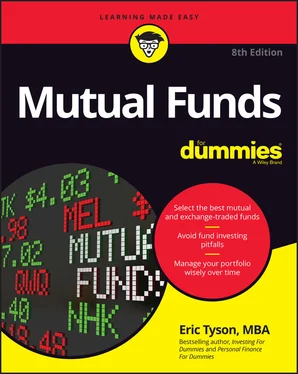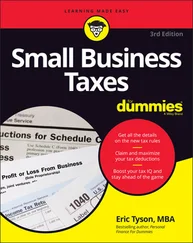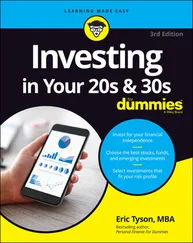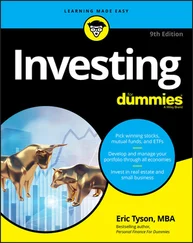Eric Tyson - Mutual Funds For Dummies
Здесь есть возможность читать онлайн «Eric Tyson - Mutual Funds For Dummies» — ознакомительный отрывок электронной книги совершенно бесплатно, а после прочтения отрывка купить полную версию. В некоторых случаях можно слушать аудио, скачать через торрент в формате fb2 и присутствует краткое содержание. Жанр: unrecognised, на английском языке. Описание произведения, (предисловие) а так же отзывы посетителей доступны на портале библиотеки ЛибКат.
- Название:Mutual Funds For Dummies
- Автор:
- Жанр:
- Год:неизвестен
- ISBN:нет данных
- Рейтинг книги:3 / 5. Голосов: 1
-
Избранное:Добавить в избранное
- Отзывы:
-
Ваша оценка:
- 60
- 1
- 2
- 3
- 4
- 5
Mutual Funds For Dummies: краткое содержание, описание и аннотация
Предлагаем к чтению аннотацию, описание, краткое содержание или предисловие (зависит от того, что написал сам автор книги «Mutual Funds For Dummies»). Если вы не нашли необходимую информацию о книге — напишите в комментариях, мы постараемся отыскать её.
Mutual Funds For Dummies
Mutual Funds For Dummies
Mutual Funds For Dummies — читать онлайн ознакомительный отрывок
Ниже представлен текст книги, разбитый по страницам. Система сохранения места последней прочитанной страницы, позволяет с удобством читать онлайн бесплатно книгу «Mutual Funds For Dummies», без необходимости каждый раз заново искать на чём Вы остановились. Поставьте закладку, и сможете в любой момент перейти на страницу, на которой закончили чтение.
Интервал:
Закладка:
You don’t share in the success of the organization to which you lend your money. If the company doubles or triples in size and profits, the growth is good for the company and its owners. As a bondholder (lender), you’re sure to get your interest and principal back, but you don’t reap any of the rewards. If Elon Musk had approached you years ago for money for his then new company Tesla, would you rather have loaned him the money or owned a piece of his company?
Ownership investments: More potential profit (and risk)
You’re an owner when you purchase an asset, whether a building or part of a multinational corporation, that has the ability to generate earnings or profits. Real estate and stock are common ownership investments.
 Ownership investments can generate profits in two ways:
Ownership investments can generate profits in two ways:
Through the investment’s own cash flow/income: For example, as the owner of a duplex, you receive rental income from tenants. If you own stock in a corporation, many companies elect to pay out a portion of their annual profits (in the form of a dividend ).
Through appreciation in the value of the investment: When you own a piece of real estate in an economically vibrant area or you own stock in a growing company, your investment should increase in value over time. If and when you sell the investment, the difference between what you sold it for and what you paid for it is your (pre-tax) profit. (The IRS, of course, will eventually expect its share of your investment profits.) This potential for appreciation is the big advantage of being an owner versus a lender.
On the downside, ownership investments may come with extra responsibilities. If the furnace goes out or the plumbing springs a leak, you, as the property owner, are the one who must fix and pay for it while your tenant gets to kick back in their recliner watching football games and eating nachos. And you’re the one who must pay for insurance to protect yourself against risks, such as fire damage or accidents that occur on your property.
Moreover, where the potential for appreciation exists, the potential for depreciation also exists. Ownership investments can decline in value as we saw happen in the early 2000s, late 2000s, and in early 2020. Real estate markets can slump, stock markets can plummet, and individual companies can go belly up. For this reason, ownership investments tend to be riskier than lending investments.
Surveying the Major Investment Options
When you understand that fundamentally two major kinds of investments — ownership and lending — exist, you can more easily understand how a specific investment works … and whether it’s an attractive choice to help you achieve your specific goals.
Which investment vehicle you choose for a specific goal depends on where you’re going, how fast you want to get there, and what risks you’re willing to take. Here’s an inventory of investment vehicles to choose from, along with my thoughts on which vehicle would be a good choice for your situation.
Savings and money market accounts
You can find savings and money market accounts at banks; money market funds are available through mutual fund companies. All are lending investments based on short-term loans and are about the safest in terms of short-term risk to your investment among the various lending investments around. Relative to the typical long-term returns on growth-oriented investments, such as stocks, the interest rate (also known as the yield ) paid on savings and money market accounts is low but doesn’t fluctuate as much over time. (The interest rate on savings and money market accounts generally fluctuates as the level of overall market interest rates changes.)
Bank savings accounts are backed by an independent agency of the federal government through Federal Deposit Insurance Corporation (FDIC) insurance. If the bank goes broke, you still get your money back (up to $250,000 per depositor, per insured bank). Money market funds, however, aren’t insured.
 Should you prefer a bank account because your investment (principal) is insured? No. Savings accounts and money market funds have essentially equivalent safety, but money market funds tend to offer higher yields. Chapter 11provides more background on money market funds.
Should you prefer a bank account because your investment (principal) is insured? No. Savings accounts and money market funds have essentially equivalent safety, but money market funds tend to offer higher yields. Chapter 11provides more background on money market funds.
Bonds
Bonds are the most common lending investment traded on securities markets. Bond funds also account for about 20 percent of all mutual fund assets and about 15 percent of all exchange-traded funds. When issued, a bond includes a specified maturity date — the date when your principal is repaid. Also specified when a bond is issued is the interest rate, which is typically fixed (meaning it doesn’t change over time).
Bonds, therefore, can fluctuate in value with changes in interest rates. If, for example, you’re holding a bond issued at 2 percent and the market level of interest rates increases to 4 percent for newly issued similar bonds, your bond will decrease in value. Why would anyone want to buy your bond at the price you paid if it yields just 2 percent when they can get a similar bond yielding 4 percent somewhere else? (See Chapter 12for more information.)
Bonds differ from each other in the following ways:
The type of institution to which you’re lending your money: Institutions include state and local governments (municipal bonds), the federal government (Treasuries), mortgage holders (the Government National Mortgage Association, or GNMA), and corporations (corporate bonds). Foreign governments or corporations can also issue bonds. The taxability of the interest paid by a bond is tied to the type of entity issuing the bond. Corporate, mortgage, and foreign government bond interest is fully taxable. Interest on government bonds issued by U.S. entities is usually free of state and/or federal income tax.
The credit quality of the borrower to whom you lend your money: The probability that a borrower will pay you the interest and return your entire principal on schedule varies from institution to institution. Bonds issued by less-creditworthy institutions tend to pay higher yields to compensate investors for the greater risk that the loan will not be fully repaid.
The length of maturity of the bond: Short-term bonds mature in a few years, intermediate bonds in around 5 to 10 years, and long-term bonds within 30 years. Longer-term bonds generally pay higher yields, but their value is more sensitive to changes in interest rates.
Stocks
Stocks are the most common ownership investment traded on securities markets. They represent shares of ownership in a company. Companies that sell stock to the general public (called publicly held companies) include aircraft manufacturers, automobile manufacturers, banks, computer software producers, ecommerce companies, food manufacturers, hotels, mining companies, oil and gas firms, publishers, restaurant chains, supermarkets, wholesalers, and many types of other (legal) businesses!
When you hold stock in a company, you share in the company’s profits in the form of annual dividends (although some companies don’t pay dividends) as well as in an increase (you hope) in the stock price if the company grows and makes increasing profits. That’s what happens when all is going well. The downside is that if the company’s business declines, your stock can plummet or even go to $0 per share.
Читать дальшеИнтервал:
Закладка:
Похожие книги на «Mutual Funds For Dummies»
Представляем Вашему вниманию похожие книги на «Mutual Funds For Dummies» списком для выбора. Мы отобрали схожую по названию и смыслу литературу в надежде предоставить читателям больше вариантов отыскать новые, интересные, ещё непрочитанные произведения.
Обсуждение, отзывы о книге «Mutual Funds For Dummies» и просто собственные мнения читателей. Оставьте ваши комментарии, напишите, что Вы думаете о произведении, его смысле или главных героях. Укажите что конкретно понравилось, а что нет, и почему Вы так считаете.












